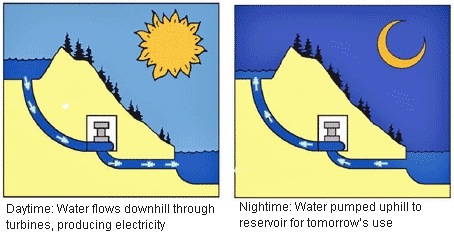Hydroelectric power is the use of falling water to generate electricity. One form of this technology is Pumped-storage hydroelectricity (PSH). “In a pumped storage facility, water is pumped during off-peak demand periods from a reservoir at a lower elevation for storage in a reservoir at a higher elevation. Electricity is then generated during peak demand periods by releasing the pumped water from the higher reservoir and allowing it to flow downhill through the hydraulic turbine(s) connected to generators,” according to the California Energy Commission.
image from: U.S. Department of the Interior/U.S. Geological Survey
In the last few years, there has been an uptick in preliminary permit applications for Pumped-storage hydroelectricity (PSH): over 100 filed in the last 5 years. In contrast, during the 7 years prior there were less than 25 applications filed. The Federal Energy Regulatory Commission (FERC) “has authorized a total of 24 pumped storage projects that are constructed and in operation, with a total installed capacity of approximately 16,500 megawatts,” according to FERC’s website. “Most of these projects were authorized more than 30 years ago.” So why is this relatively old technology suddenly gaining in popularity? (Hint: it has to do with profit.)
For answers, let’s examine one such plant located along the eastern shoreline of Lake Michigan near Ludington, MI. The plant was opened in 1973, is jointly owned by Consumers Energy and Detroit Edison, and operated by Consumers Energy. Existing generating capacity is 1,872 MW with a planned upgrade to 2,172 MW by 2019. “This electricity is sent to customers throughout Michigan’s Lower Peninsula,” according to Consumers Energy. “The total output is enough to power a city of 1.4 million people.”
Pumped-storage hydroelectricity (PSH) is controversial in terms of its green credentials. It does not directly create pollution, but in pumping water uphill to recharge it actually uses more electricity than it generates. The reason it is economically viable is because the rates are lower at night when it is pumping uphill. Consumers Energy does mention, “The plant itself does not consume fossil fuels such as coal or oil or require the expensive handling of waste materials.” However, “the power used to pump water into the reservoir does come from power plants using other fuels.”
The reason this is still considered a green energy is because it is most economical to run the plant (with water power) at times of peak load on the grid, which means it keeps other peak load projects (that could instead be burning fossil fuels during peak load) from being built. All electricity grids need to ensure they have enough generating capacity to not only meet their normal expected baseload but also to meet a spiking peak load. Non-hydro renewables such as wind and solar power cannot be controlled for when they will be generating electricity. Project engineer Brian Zatloukal explains that the Ludington plant helps meet customer demand at key times. “It enhances our ability to balance the fluctuating output of increasing numbers of wind turbines within the renewable energy segment,” he said.
Kent works at RealPage and helps apartment firms reduce operating costs related to utilities. You can connect with Kent at LinkedIn.com/in/kentmcd or Twitter.com/AptsKent.
